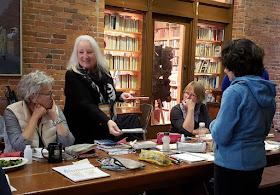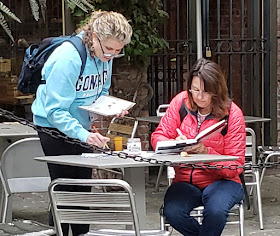 |
| 8/25/18 Michele demo-ing the 6-stroke figure inside Grand Central Arcade |
Although
Michele Cooper has taught First
Steps in Visual Journaling several times, I’ve always managed to be out of town
when it was offered. Yesterday I was finally able to catch up with her in
Pioneer Square to sketch and photograph her popular USk 10x10 workshop in
action. Known for her delightful sense of humor, Michele gently eased her
students toward documenting their day’s activities with sketches and words.
The
exercise I caught her demo-ing was her signature “6-stroke people” – like stick
figures but with realistic human proportions – which she uses frequently to
sketch people in the middle and far distance of an urban environment. Steering
her students away from getting bogged down by facial or clothing details, she
suggested that they “indicate, don’t illustrate.”
 |
| Michele showing some of her favorite sketch tools. |
The
smoky sky was back again, which kept her workshop mostly indoors. Undaunted, Michele
showed her students that urban sketchers adapt to changing, unpredictable circumstances,
and they made themselves at home inside Grand Central Arcade.
After
eavesdropping on Michele and her students for a while, I became famished and
decided I needed a sandwich from Grand Central Bakery. You know I rarely sketch
my food: If I’m hungry enough to have it in front of me, I’m too hungry to sketch
it. However, inspired by Michele’s montage style of visual journaling, I stopped
myself from devouring the sandwich long enough to make the world’s fastest
sketch. After scarfing it down, I looked around Grand Central Arcade to make a
couple of small sketches next to the sandwich: Michele giving a demo and one of
the ceiling lamps.
Before
heading home, I walked out to Occidental Park to fill the rest of the page with
some ping-pong players and a flower basket hanging from an iconic Pioneer Square
lamp post. I guess the sandwich didn’t have to be quite so prominent on the
page, but that’s what happens when I sketch hungry.
 |
| 8/25/18 Inspired by Michele's montage style, here's my sandwich center stage surrounded by other elements of my day. |
 |
Some of Michele's students ventured outdoors to Occidental
Park to practice their 6-stroke figures. |



















































